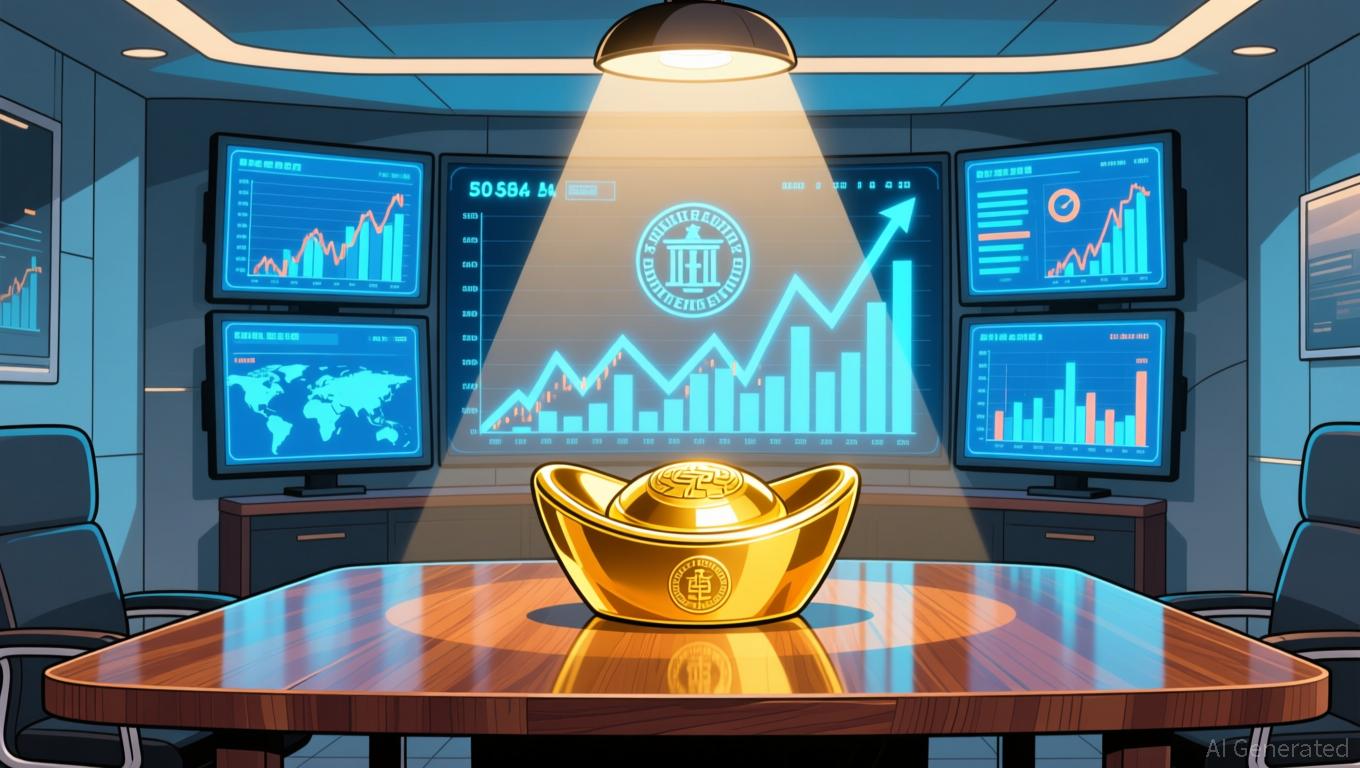Gold Climbs as Fed Faces Uncertainty Over December Rate Cut Amid Limited Data
- Gold prices hit $4,120/oz as Fed rate cut expectations dropped to 33% due to delayed November jobs data, triggering market uncertainty. - JPMorgan and Goldman Sachs project gold to reach $5,055/oz by 2026, citing central bank demand and potential Fed policy neutrality. - Asian markets showed mixed performance while U.S. equity futures wavered, reflecting fragility amid geopolitical tensions and Fed leadership speculation. - Geopolitical risks, including U.S.-Ukraine peace talks and China's semiconductor
Gold Achieves Record November Surge Amid Fed Uncertainty
Gold prices soared to their highest November levels in recent years, reaching $4,120 per ounce. This rally came as investors adjusted their outlooks for a potential Federal Reserve interest rate reduction in December, following a series of events that dramatically shifted market sentiment. The ongoing debate between hopes for monetary easing and the unpredictability of the Fed’s data-driven strategy is shaping global investment decisions and asset allocations.

Labor Data Disruptions Shake Market Expectations
Market volatility intensified after the Bureau of Labor Statistics announced the cancellation of October’s employment report due to a government shutdown. As a result, the release of November jobs figures was postponed until after the Fed’s December 2025 policy meeting. This unexpected delay caused the likelihood of a December rate cut to plummet from nearly certain to just 33%, according to CME FedWatch. Without this crucial data, the Fed’s upcoming decision will rely heavily on current economic indicators, with investors closely tracking inflation and corporate earnings for clues on future policy moves.
Drivers Behind Gold’s Rally
The surge in gold prices has been propelled by both central bank purchases and speculative investments anticipating lower interest rates. Experts from JPMorgan and Goldman Sachs forecast that gold could climb to $5,055 per ounce by the end of 2026, citing ongoing central bank demand and the possibility of the Fed adopting a more neutral stance. Additionally, companies like Lake Victoria Gold and White Gold Corp. have announced promising drilling outcomes, further boosting confidence in gold’s long-term prospects.
Ripple Effects Across Global Markets
Uncertainty surrounding the Fed’s policy has affected other markets as well. Asian stocks, which had previously rallied on expectations of rate cuts, experienced mixed results as the delayed jobs data muddied the outlook. Japan’s Nikkei 225 and Topix Index rebounded from early declines, supported by a weaker yen and improved trade relations between China and the U.S. Meanwhile, Chinese equities continued to rise, buoyed by stimulus measures and increased liquidity from the People’s Bank of China. In contrast, U.S. equity futures slipped after a tech-led recovery, highlighting the fragile mood ahead of the Fed’s final meeting of the year.
Fed Leadership and Geopolitical Factors Add Complexity
Further complicating the landscape, Bank of America identified Kevin Hassett as a leading candidate for the next Fed Chair, noting his alignment with President Trump’s preference for lower interest rates. Should Hassett take the helm, a shift toward more accommodative policy could accelerate in 2026, though analysts warn that the ultimate pace of rate cuts will depend on the makeup of the FOMC and incoming economic data.
Geopolitical developments are also influencing the Fed’s decision-making. While the U.S. and Ukraine have reached a preliminary agreement on a revised peace plan, Russia’s resistance and its efforts to postpone new oil sanctions have added layers of risk. At the same time, China’s ambitions in the semiconductor sector and ongoing disputes with Dutch firm Nexperia highlight vulnerabilities in global supply chains—an issue the Fed must consider as it weighs inflation against economic growth.
Outlook: Gold’s Safe Haven Status Endures
Looking forward, gold’s direction will largely depend on how the Fed navigates its December meeting amid limited economic data. An unexpected rate cut could propel gold prices toward $5,000, while a decision to hold rates steady may see the metal maintain its recent gains amid ongoing market turbulence. For now, the combination of delayed economic reports, evolving Fed leadership prospects, and geopolitical tensions has reinforced gold’s reputation as a reliable safe haven in uncertain times.
Disclaimer: The content of this article solely reflects the author's opinion and does not represent the platform in any capacity. This article is not intended to serve as a reference for making investment decisions.
You may also like
Cardano News Update: Cardano Bets $70M in ADA—Will Infrastructure Improvements Drive Expansion?
- Cardano's stakeholders seek 70M ADA from Treasury to fund 2026 growth via infrastructure upgrades, led by IOG, EMURGO, and key foundations. - Proposed upgrades focus on stablecoin integration, cross-chain bridges, and institutional tools to attract capital and scale DeFi, addressing TVL stagnation at $190M. - Milestone-based funding aims to ensure accountability, aligning with institutional demands for secure custody and analytics while avoiding speculative ventures. - Market analysis shows cautious opti

Tech's $96B Bet on AI: Borrowing Spree Could Spark Another Bubble
- Tech sector's AI debt surged to $96B as firms like OpenAI, Oracle , and CoreWeave secure massive loans to expand infrastructure. - Oracle's 9.17% stock drop highlights risks of overreliance on OpenAI, with DA Davidson cutting its price target due to "fake it 'till you make it" concerns. - CoreWeave's $7.5B credit facility and tripled interest costs mirror 2008 crisis-era CDO risks, raising sustainability questions for AI-driven growth. - xAI's $15B funding round and OpenAI's $40B private raise underscore

Philanthropist MacKenzie Scott Tackles Educational Disparities Using a Blended Loan Approach
- Philanthropist MacKenzie Scott invests in Funding U, a startup offering merit-based student loans without co-signers, inspired by her own $1,000 college loan. - The hybrid model combines Scott's "junior debt" with bank funding, using algorithms to assess academic potential rather than credit scores. - This approach targets low-income students, blending philanthropy with market incentives to address educational inequity and systemic barriers. - The investment reflects growing trends in impact investing, w
Tokenized Stocks Gain Momentum as Crypto Meets TradFi